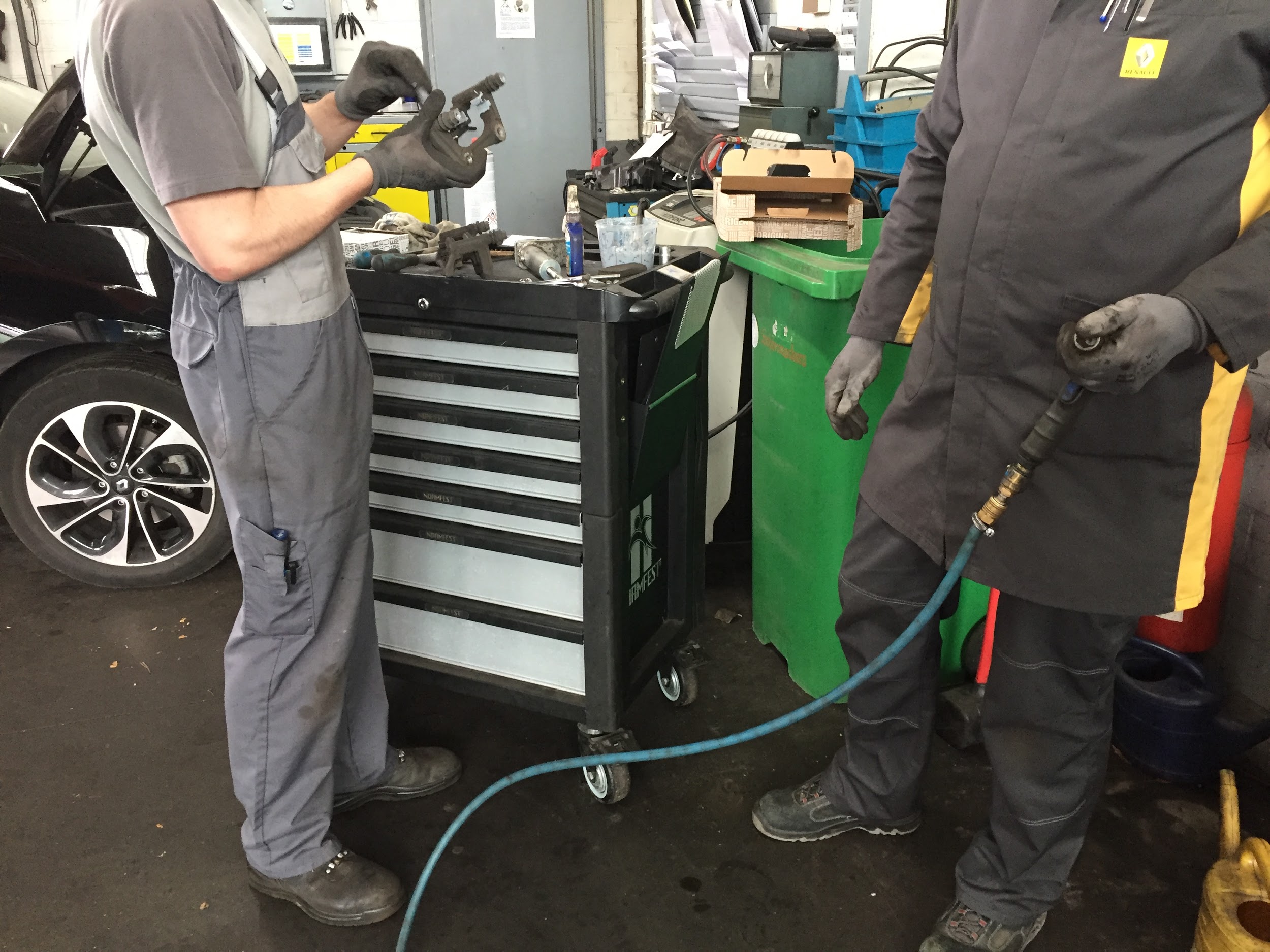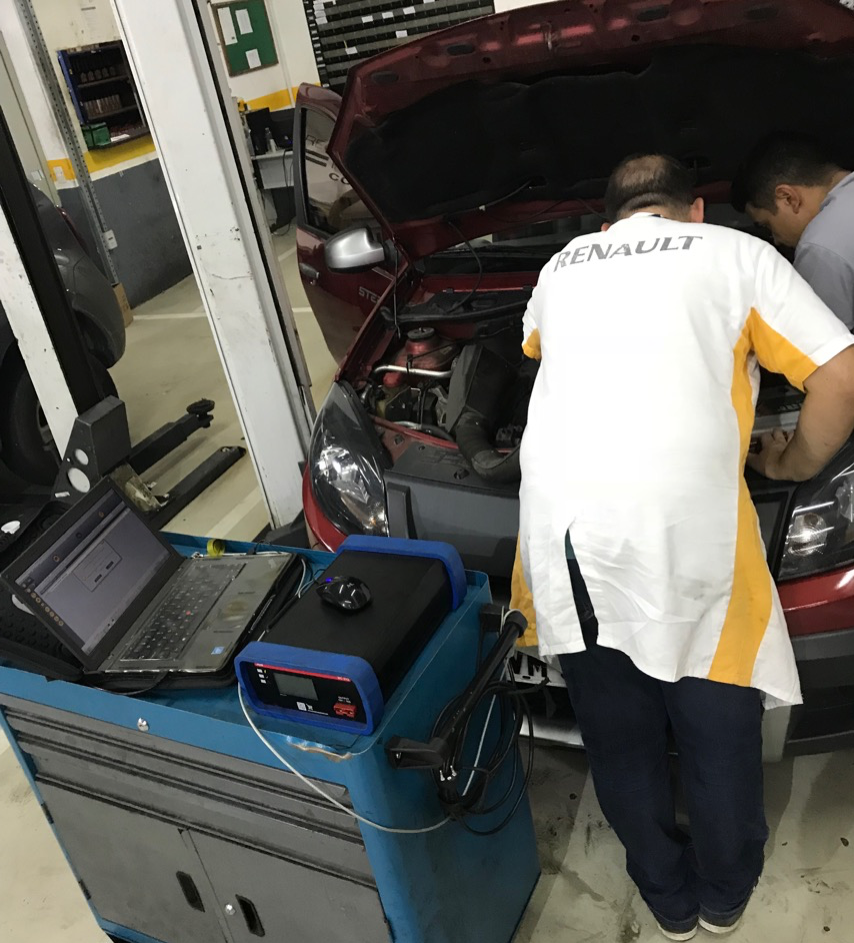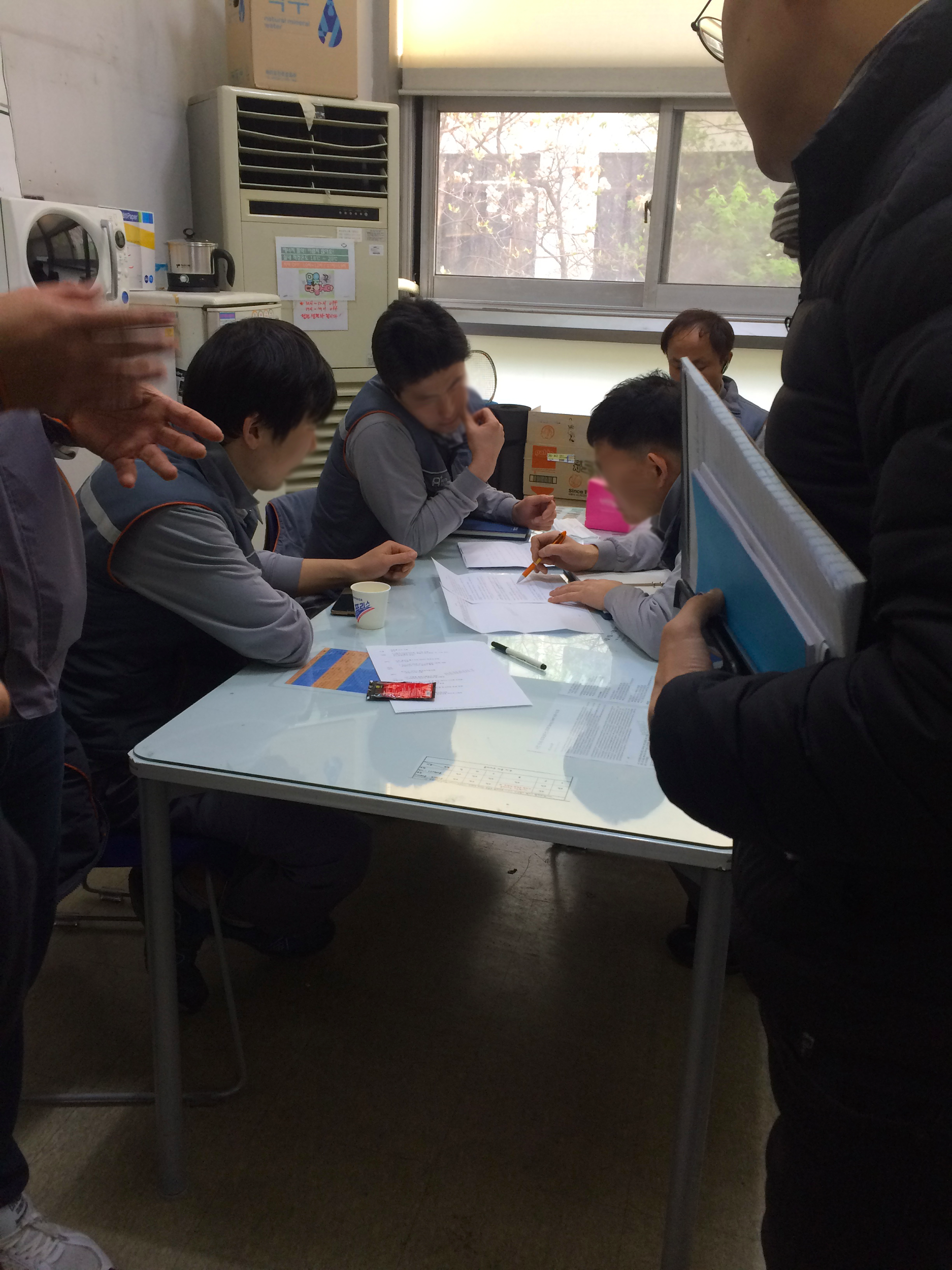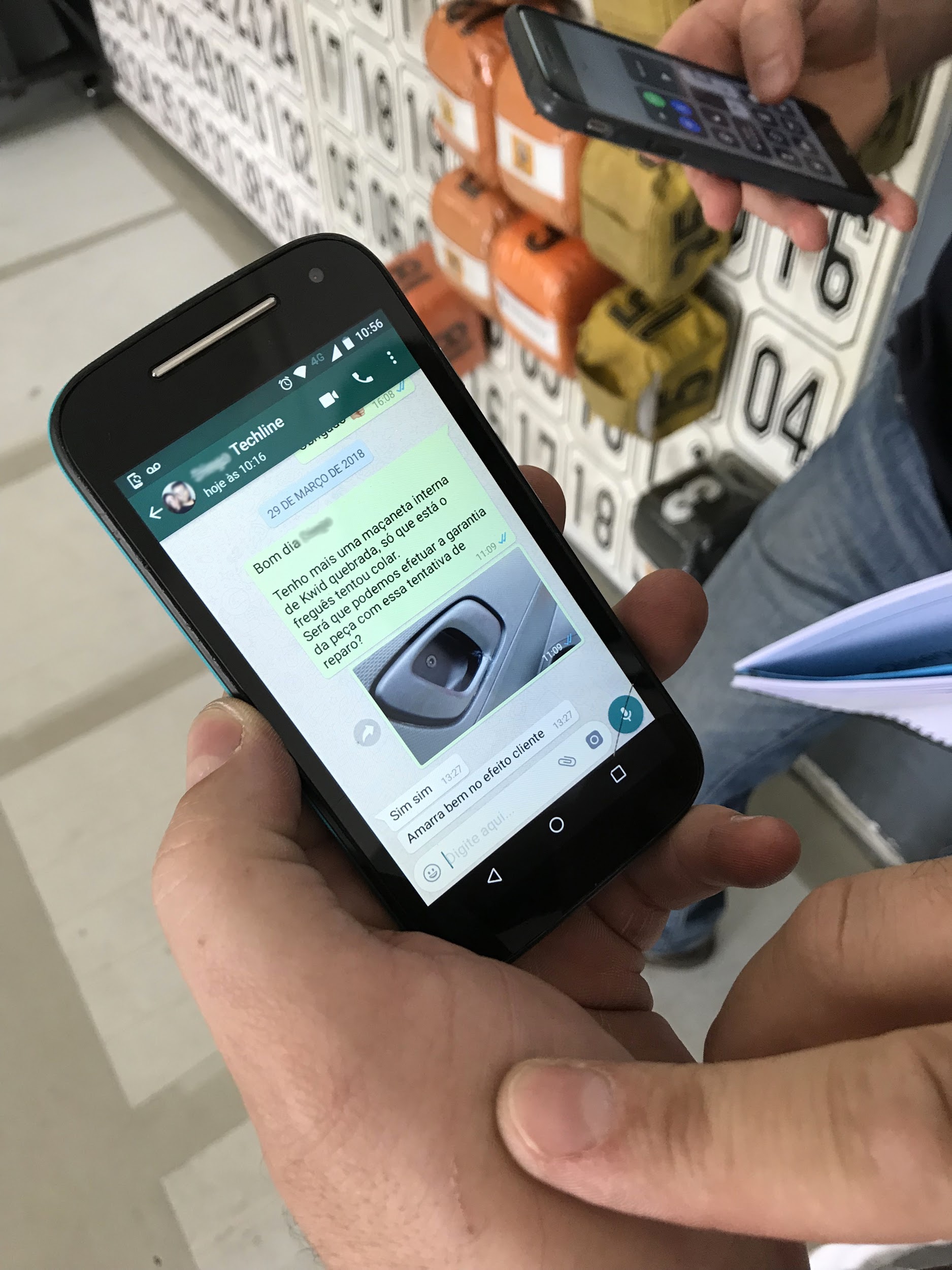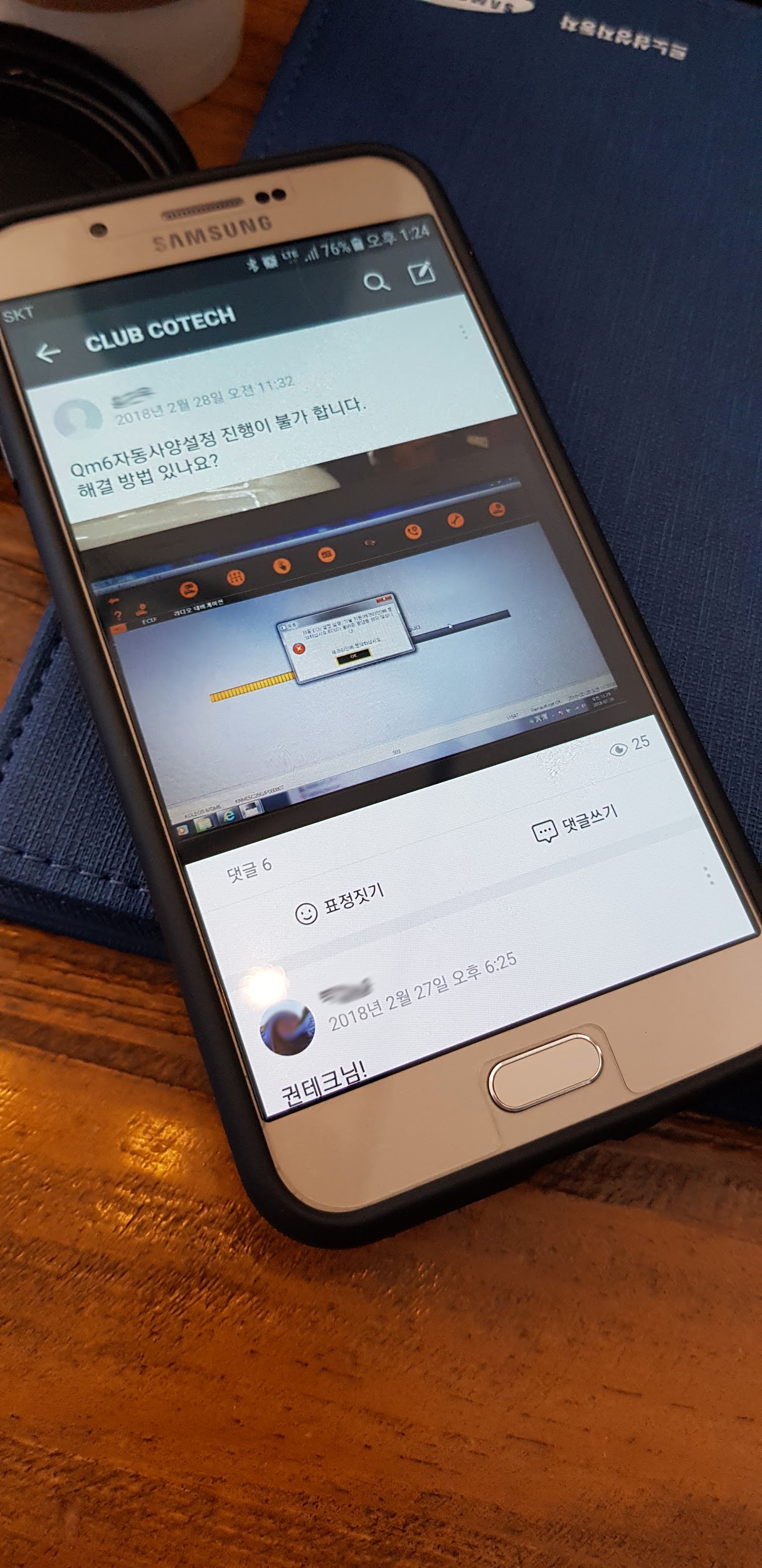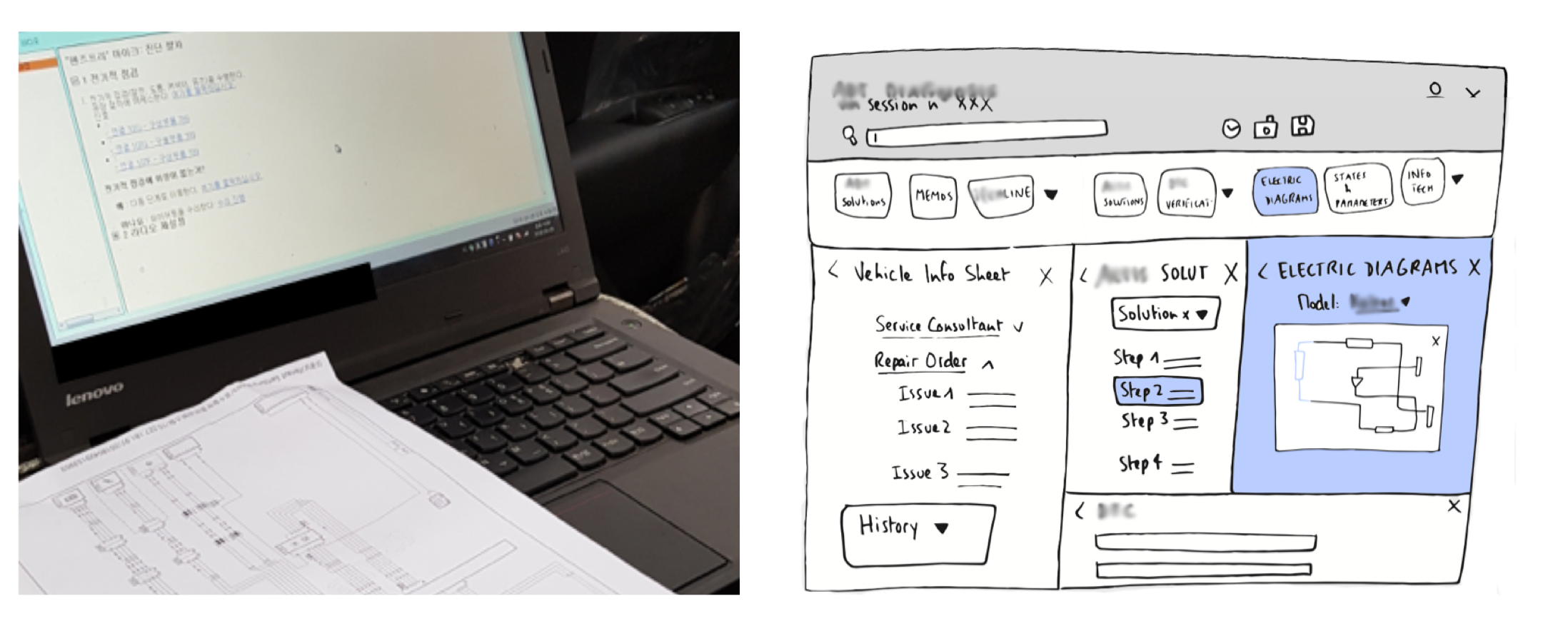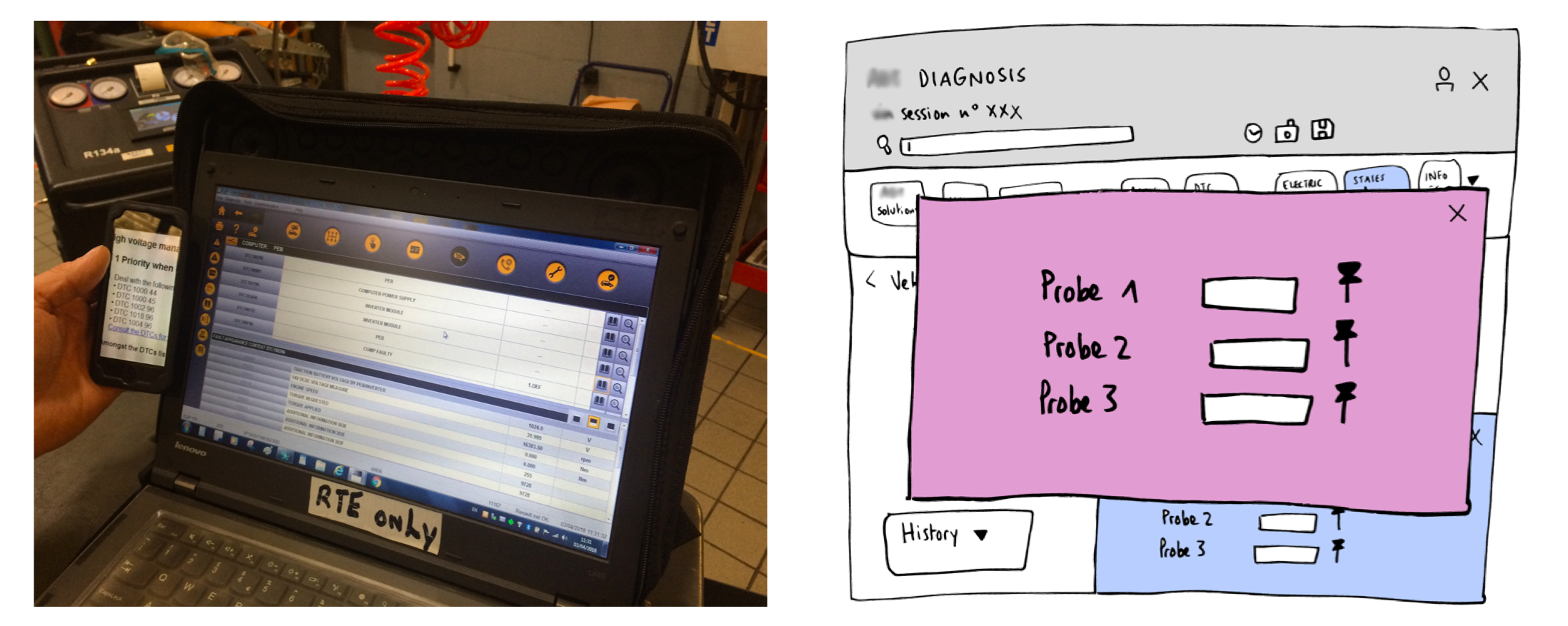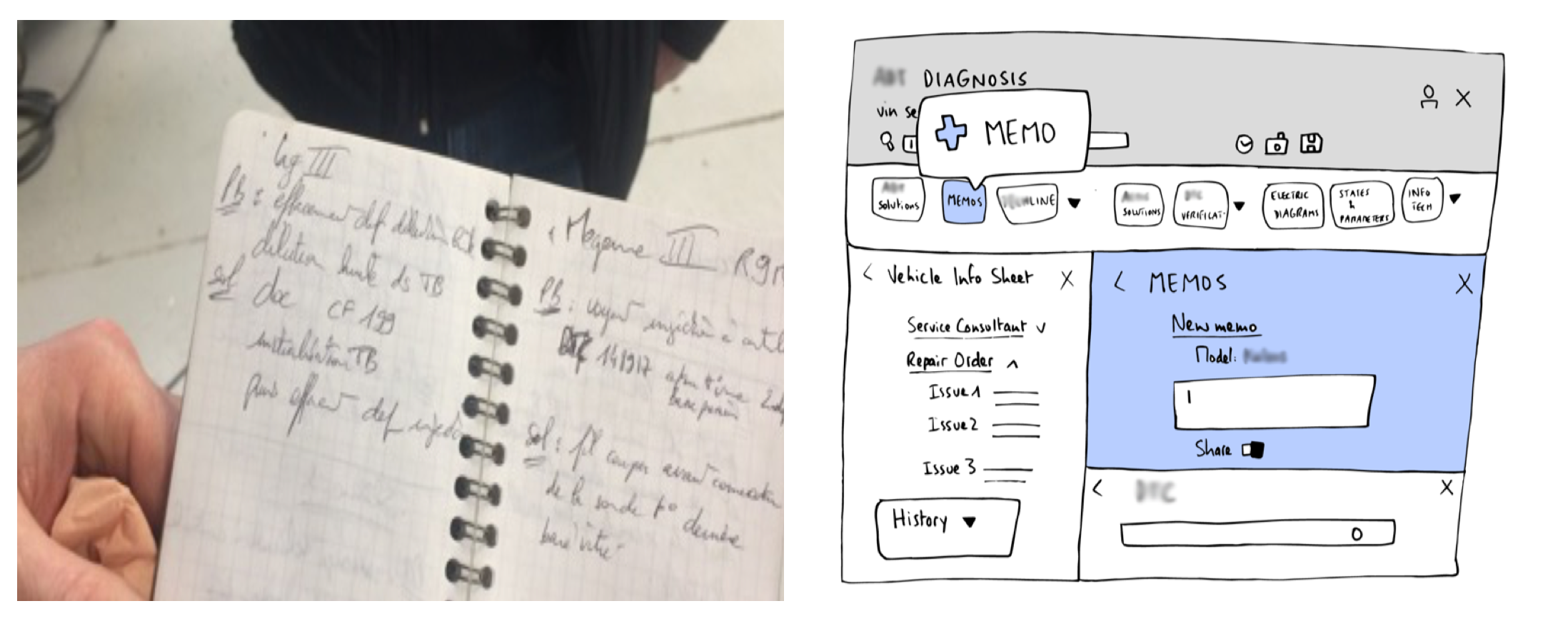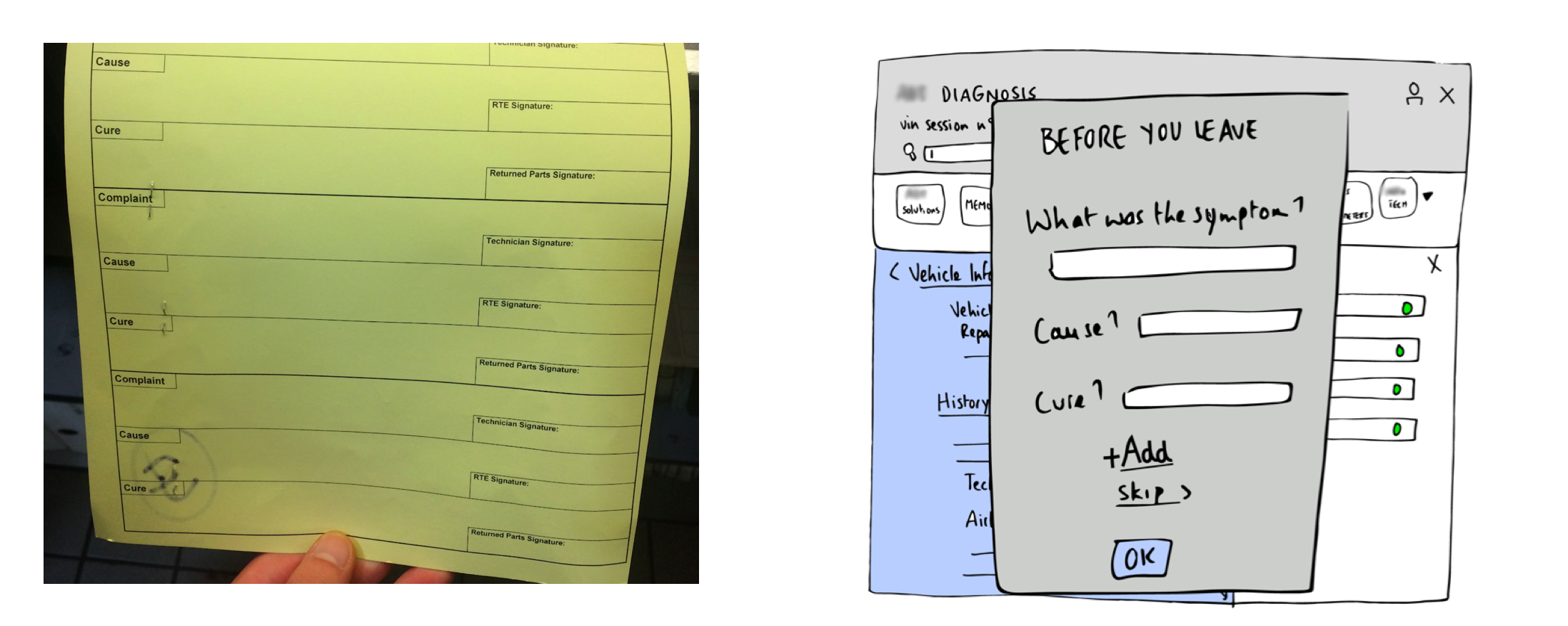As part of an international research conducted for a French car manufacturer, a team of anthropologists and designers were asked to analyze the use of a car diagnostic tool by mechanics in their garages, in order to recommend ways of improving it. A single glance at the diagnostic tool’s interface was enough to get a feel for mechanics’ new reality: lines of codes and numbers, webpages filled with blue hyperlinks leading to readymade repair methods. Does being a mechanic in an automation era mean anything anymore? Based on findings from a study conducted in 5 countries with mixed ethnographic and UX methods, this case study explicits the interest of understanding mechanics as a profession – or even more, as an art – before studying the use of the tool itself, and mostly, it demonstrates how solutions can be contained in agency – and how design and tech teams can find inspiration from bypasses, local initiatives, and informal rituals. From supervising an international team of researchers to finding similarities among cultural specificities, this paper also questions ethics and investigates the role of a diagnostic tool in supporting mechanics’ job evolution.
INTRODUCTION
What strikes at first sight, when lifting a recent vehicle’s hood, is the unintelligible entanglement of electronic components around the engine. To drivers, cars seem to progressively have become more electronic, autonomous – and mostly, obscure. To mechanics too – if not more. For decades, engineers have been transforming cars’ systems into complex networks, introducing a sharp turn into the mechanical profession. Take away the throttle valve switch and you take away the essence of mechanics and their greasy overalls. Put in air conditioning and you take out the need for senses and guts. No touching, no smelling, no listening.
For quite a while, from the 19th century up to the mid-20th, vehicles were understood as “front-mounted gasoline engine, transmission behind that, drive wheels in the rear, all suspended on frame rails with a body on top” (Borg 2012, 28–29) – it was as simple as that. Cadillac’s first electrical starters in 1912 were the premise of progressive complexification of cars systems. But mostly, it was the context of WWII and the Cold War that spawned technical uncertainty1, by encouraging innovation in the context of rivalry. Technical uncertainty extended in the 1960s and 1970s with uprising ecological concerns to reduce gas emissions. The 1970 Clean Air Act Amendments led to the creation of the catalytic converter and of the On-Board Diagnostic (OBD) system to access the data and control the gas emissions, making it the first human-machine interface.
From then on, embedding new technologies meant creating tools to translate the automated maintenance system for mechanics, instead of supporting olfaction, audition, or other senses that they had always relied on. But engineers seemed to have forgotten to take the mechanics into consideration within the design process, imposing digital interfaces that didn’t adapt to their work routines and habits. With each new generation of cars came new on-board technology, and with it new functionalities and processes, leading to major changes within the diagnostic tools.
In the context of revamping their diagnostic tool before launching the next model generation, the leading French car manufacturer asked the _unknowns research & design team to help improving it. To the manufacturer, not only was it a necessity – as they were cutting profits to attract new customers, maintenance and service department had become a critical income source – making car diagnostics more efficient was also a major business issue, as well as an HR one. The entire industry faces a shortage in qualified technicians – partly because automated diagnostic systems have depreciated jobs, making them less attractive: for an increasing number of students, it isn’t a vocation anymore (Mayersohn 2017). Revamping the diagnostic tool meant tackling several challenges: reducing overall diagnostic operations length, reducing the number of errors in maintenance, and developing mechanics’ expertise and satisfaction with the diagnostic tool. Those challenges required a deep understanding of the job. It required to apprehend what diagnosing actually meant, and to figure out how the current diagnostic tools were really used within the garages. In short, the goal for the research was to observe mechanics’ agency in an automated car diagnostic context. The _unknowns researchers were integrated to the car manufacturer’s engineering team in charge of redesigning the tool. Their role was to conduct an international study and provide UX guidelines to improve the usage of the diagnostic tool.
Before diving into the case study, side note: for those who aren’t familiar with oily cylinders, injection pumps and mechanical matters (and the researchers themselves were first in line), what was mentioned as a “diagnostic tool” may sound enigmatic. To put it simply, it is a computer software which is plugged in and linked to a vehicle with a probe. It is used to interpret and command the vehicle processors and ECUs (Electronic Command Unit or Engine Command Unit). Almost all vehicles’ functions can be measured and controlled through the diagnostic tool. From their laptops, mechanics can detect defective spark plugs, measure the play of an unbalanced crankshaft, and even start the engine. Mostly, diagnostic tools have become mandatory to diagnose cars faults and failures. Any malfunction imprints electronic records that are meticulously kept within the ECUs. Those records are interpreted through the diagnostic tool and used by the mechanics to find the failures’ causes. Nowadays, as vehicles are supporting more and more automated systems, diagnostic tools tend to be more automated and prescriptive – therefore imposing a standardized way to diagnose onto the mechanics.
DESIGNING AN INTERNATIONAL STUDY
When the _unknowns research team started to work on the project, it was already at an advanced stage, thus setting the study in a peculiar context. Decisions and design choices had already been taken regarding the new diagnostic tool – leaving little room for local adaptations. The goal was to create a single diagnostic tool for all the car manufacturer garages all over the world. To sum up: one tool to rule them all.
As the tool was meant to match any context, country and culture worldwide, the _unknowns team needed to design an international study to uncover both common grounds and differences in car diagnostic, as well as the usages of the current tool. The team opted for a comparative approach. The countries were chosen as a consensus between scientific interests, business priorities and project constraints, as it was mundanely limited in time and budget. The idea was to use the garages as samples to capture as much diversity as possible in terms of cultural contexts, organizational structures and market sizes – within, of course, a given budget and a set timeframe. Ultimately, the decision was made to carry out the fieldwork in 17 garages spread out onto 5 countries: France, UK, Germany, Brazil and South Korea.
Field Strategy
Given the complexity and the high level of expertise required, rushing headlong into a garage would have resulted in leaving ethnographers and designers stuck, confused by the flood of technical terms and gestures. To avoid the pitfall, the research started with an immersion and training phase to ramp up the team’s knowledge about mechanics and tools used in the garages. The fieldwork was conducted within two sequences. The team started with an exploratory research in France to surface first findings that would then be compared with those uncovered in the other countries. The second part was to go all-out, worldwide – the clock was ticking. Backed by the field experience in France, the international fieldwork was carried out in the 4 other countries simultaneously, to confirm, challenge and enrich previous findings. That research strategy aimed at balancing the project’s constraints with the most robust and rigorous fieldwork possible, in order to identify patterns and insight to redesign a global diagnostic tool.
Directing an International Field Study
Given the cultural specificities that were taken into account when framing the research, the team decided to rely on local ethnographers, as it was necessary to take cultural variables into consideration from the start. Therefore, the research framework and study protocol was shared with the local partners as soon as it was designed, in order to make marginal adjustments. It was crucial to share the knowledge acquired by the _unknowns research team during the immersion and training phase. In order to bring the local researchers up to speed with the topic, the team provided them with a complete briefing, involving custom-made books, videos and remote work sessions. They needed to be sure that no questions had been left unresolved. To further ensure local researchers were in the best possible set-up to conduct the fieldwork, each of them was paired up with a member of the research team. The coaching and support was also ensured through close communication such as daily briefing from start to finish.
Building the Research Framework
To understand the usage of the diagnostic tool, and more generally the logic of diagnosing, the team had to take a step back to grasp garages and mechanics in a broader perspective. They focused on three main aspects to direct the study.
- Mechanics and their job. The team’s goal was to study mechanics as a profession (Abbott 1988), investigating its culture, core competencies, jurisdiction and internal structure in the workplace. What were the different roles and positions that mechanics played within the garage, what were the official and tacit hierarchies that may have existed, etc.
- The environment, i.e. the garage as a stage on which the action takes place. Since the mechanics’ everyday work took place in a specific environment, the team needed to study the garage organization, its objectives, its rules, and how they affected the repairing process and the tool usage. The works from the organizations theory field2 were used to help frame the study and analyze the findings.
- The diagnostic tool. An emphasis was placed on observing how the diagnostic tool was used and combined along with other resources. From an Actor Network Theory perspective (Latour & Woolgar 1979, Callon 1986), a special focus was put on how workers juggle the different resources available to achieve their goals.
The main research techniques were direct observations and informal interviews with mechanics and other workers in the garage. In each garage, the researchers were usually introduced to the staff by a senior mechanic, and stayed for 2 or 3 days long. The methodology employed was basic, from observing gestures to discussing them. The idea was to observe cases of car failures: ask the mechanic if it was possible to stay with him during his task, and if so, record all the gestures and all the steps, going from errors or doubts to victories. The researchers had created research field books to facilitate observations. The conversation generally slipped to broader aspects of the job: memorable past cases, life in the garage as a mechanic, career desires and personal thoughts on the way the job had evolved since they began to work. Shifting from direct observations to informal interviews was a good way to gather valuable material for the research.
But let’s go back a little. Having built a research protocol and agreed on a comparative approach for the study, the researchers were set to go. Problem: they weren’t mechanics. At all. To integrate themselves and mingle, they needed to get their hands dirty.
DIVING (DEEP) INTO THE GARAGE: FIRST ATTEMPTS INTO BLENDING IN
Step one of the immersion phase involved getting the engine starting – literally. The team had a DIY “build-your-own-plastic-car-engine” shipped to their Paris office. Having the type of toy you might offer your nephew or niece for their birthday might seem surprising (well, to their colleagues it surely did), yet the exercise turned out to be extremely useful. First, for the vocabulary – and consequently the legitimacy. Also, and mostly, to get into the logic of mechanics: understanding the engine’s system as a whole, with all its internal links and dependencies. If the plastic engine isn’t starting, check if the piston is connected to the crankshaft by a connected rod. They don’t lie, you always learn better by doing.
Step two was an official training on the diagnostic tool. The team integrated two different student groups and mingled with the mechanics for a short back-to-school session. In the mornings, dedicated to theory, students scrupulously followed the leaflets they were given – inside, pages of screenshots, functionality descriptions and methods on how to interpret the data. It was already clear: being a mechanic today demanded digital skills. And, for some tasks, it seemed, less and less wit: guided diagnostics, for example, were accessible within the tool and simply guided users into step-by-step actions, thus normalizing practices and processes. As one of the trainers would later conclude: “with guided diagnostic, give the tool to a hairdresser, and he’ll find the cause of the failure”. Could any hairdresser really fix a car? Too soon to say – yet it already highlighted how progressive automation was offending mechanics by making some of their core competencies obsolete. For those well-experienced students, diagnosing and repairing had already been meaning researching data and interpreting it for quite a while. Electromechanics had been using voltmeters and ohmmeters for decades. But what could once have seemed logical to them now became confusing with the tool: instead of searching, thinking, and eventually understanding, the tool forced them into finding information and methods spread out across a network of websites and digital tools. But mechanics weren’t techs. And telling them that anyone could now do their job, questioning the legitimacy of those who didn’t find navigating the tool that simple, probably wasn’t the most instructive way to help them take the shift faced by their profession.
Step three was, finally, the big jump into the garage – or rather, a glimpse into what it looked like on the other side. Some first simple observations could be made. Geographically, the division was clear: between the administrative offices, the parts shop, the body shop, the mechanical repairing zone, and the electrical one. Each sector seemed to have its own role. Mechanics and electromechanics3 had distinct tasks – and the former obviously seemed to get dirtier than the latter. Pieces of clothing could attest: senior electromechanics wore white blouses, while others mechanics wore darker ones. It turned out that the white blouses were worn by Technical Coordinators, aka the garage’s experts. Not so surprising after all that their blouses were as white as those of a doctor. It also turned out that those Technical Coordinators were the only ones able to use the diagnostic tool – officially, at least, as they were the only ones who were given a token to activate it. How was that supposed to work out, having only two or three people allowed to use the diagnostic tool? Again – theory.
The researchers got to witness the diagnostic tool in action on a defective radio. The Technical Coordinator in charge first seemed to be struggling while navigating through the different functionalities – not such of a digital-native it seemed. After having tried out a guided repair method, he decided to contact the technical hotline via another one of the manufacturer’s website. The technical hotline appeared to be yet another piece of the hierarchy: a group of experienced mechanics you could contact via a platform linked to the diagnostic tool to get help on a diagnostic or repair you couldn’t figure out by yourself. It wasn’t getting simpler. Hierarchy already appeared to be an intertwined chaos and the team could already guess some of its consequences, both on the internal organization and the use of the diagnostic tool. Yet it was only the beginning…
“LE MÉCANICIEN, LE GARAGE, ET LA TWINGO”: FRANCE FINDINGS
Living the Garage Life: Repairing Under the Influence
When a client brings a vehicle into a garage, he leaves it to a receptionist, along with some basic information filled up on paper forms. That information is used to look for another crucial one: warranty. If the client’s vehicle is still covered by warranty, the manufacturer will cover for expenses, but only according to a strict list of tasks to be performed under a maximum labor time and following specific diagnostic and repairing processes (they check!). But, if it isn’t covered, all expenses will be billed to the client… and, you know it, expenses can quickly add up. But garages tend to be flexible – they still want to keep decent client satisfaction scores, which results in what Matthew B. Crawford calls a “moral tension (…) between a mechanic’s metaphysical responsibility to the machine and his fiduciary responsibility to its owner” (Crawford 2009, 141). It was common to hear stories of days spent diagnosing cars that weren’t under warranty anymore – and finally only billing a tenth of the time that had actually been spent. Obviously, achieving fast diagnostics and repairs is critical for the garages’ profitability – a consideration that weighs on mechanics’ shoulders.
Living the Garage Life: Productivity Pressure in an Uncertain Environment
When assigned to a vehicle, mechanics usually have only little information – the information is passed on from the receptionist. Most of the times, it is barely enough to understand what is wrong with the vehicle. Mechanics might need to call the client back to get more details on the vehicle’s symptoms. They might need to check the ECUs version and update them before starting any diagnostic operations. They might need to test-drive the car, or proceed to minor fixing to better characterize the symptoms. They also might have to wait for confirmation from the technical hotline or for spare parts to be delivered.
All those operations result in a fragmented and unpredictable process involving many operations, workers, and tools. Cars can’t be fixed in one go. And, not only are mechanics having to handle constant back-and-forth operations on a vehicle, they also have to juggle with handling other cars and dealing with administrative work at the same time. It’s non-stop communication with the warranty department, providing pictures of broken parts or screenshots of the diagnostic tool showing abnormal values. An efficient mechanic appears to be not only literated in mechanics but also able to make his way through the car manufacturer procedures. And all that, in minimum time. Call it impossible? Alex, a mechanics in Chalon-sur-Saône, described: “I’m the only one with experience here, but nobody is in charge of the production planning. So as soon as a car arrives, I get one more file on my stack, in addition to the repairs I have to do, knowing that I should also make warranty agreement requests. And then I am asked to be productive!”.
Living the Garage Life: On Tricks, Tips, and Experience
To streamline the workflow and to normalize diagnoses and repairs, the manufacturer’s engineering department has set up a series of rules and methods to diagnose, confirm diagnostics, and repair. But most of them seem out of touch with the real garage world. Ed, a 10-year experienced senior mechanics in Le Mans, presented one to the research team: “It’s a method to control the starter (…) ‘Activate the starter’. Look! Look! It doesn’t make you start the vehicle, it makes you launch a start sequence. So if you do as he tells you, you cut off the fuel supply. It’s not going to start because there will be no fuel. So this step, we’re not going to do it because it’s fucked up! Yeah, it’s shitty to reactivate it… In fact, it gives you a method to control the starter alone. The easiest way is to try to start the car, if it starts you’ve saved yourself a good half an hour.” He had developed ways to bypass the non-functioning readymade methods – he could, because he had a deep understanding of each underlying system inside the car. Thanks to experience, he knew exactly which methods would lead to dead-ends, and how to wisely use the diagnostic tool. Knowing those tricks and tips made mechanics more productive – by, ironically, working against the methods that the manufacturer had precisely set up to enhance productivity. Only highly-experienced mechanics could have accumulated the knowledge, which placed them as masterminds, at the center of the garages. The essence of being a mechanic also meant sharing and passing knowledge on – which is what we’ll see in the next findings.
“I, Mechanic”: Building Certainties in Adversity, Or the Art of Diagnosing
Observing mechanics performing diagnostics for days made it obvious to the research team: diagnosing car failures was more of an art than a deterministic science. It couldn’t be reduced to a process or a set of rules. In their day-to-day work, mechanics seem to have a loose relationship with the official diagnostic rules provided by the car manufacturer: they know when to follow them scrupulously and when to ignore them.4 Yet, such creativity is demanding, requiring both knowledge and experience – what Matthew Crawford calls the “cognitive demands of manual work”. Diagnosing is a process of identifying and fixing a failure in a system. It consists in iteratively building certainties on symptoms, causes and solutions, which is why we could compare mechanics to doctors in constant trial. When facing a car failure, a mechanic has to juggle different hypothesis. Fred, a mechanic in Le Mans, told the team about an old touring car: “The engine is making a strange noise, it seems to run on 3 cylinders; I’ll change the spark plugs to see if there’s not a dead one”. Was it a dead spark plug or a bigger problem? For Fred, it was the most frequent cause to check before going any further. As Crawford pointed out, mechanics “come up with an imagined train of causes for manifest symptoms and judge their likelihood before tearing anything down” (Crawford 2009, 35).
The diagnostic process isn’t linear. New options can be tested and certainties questioned until there are no left. A good mechanic isn’t one who follows the standard procedures – it is one clever enough to imagine what the most likely causes are, and to confirm the hypothesis without risking fatal mistakes. And, to succeed, mechanics have three kinds of resources: experience, understanding of a given system, and pair’s knowledge.
Aim to Rule and Being Ruled: Destiny of a Diagnostic Tool
As observed among the garages, the current version of the diagnostic tool has pushed automation to a pinnacle. Not only does it read and display faults recorded inside the cars’ ECUs – it also invites users to apply solutions directly without understanding the real car’s failure causes. By doing so, it postulates the existence of absolute breakdowns, abstracted from concrete situations – but, of course, there are no such things in real life. It is a complete denial of the intellectual work of mechanics, forcing them into a submissive position. And mostly, a lack of consideration leading to incomprehension, time loss, and frustration when in use.
The tool doesn’t actually diagnose by itself: mastering a diagnostic still requires to use a lot of documentation, diagrams and other tools. And, when facing a mystery failure, mechanics could always find a simple solution: going back to basics. Each garage has its “mechanic library”: a room where old technical manuals are stored. Reading this literature was always of good help – as new systems are often built on the same principles as the older ones.
Depending on which kind of breakdown, bypassing the tool could be a very common practice in most of the garages. Experienced mechanics tend to avoid the guided diagnostics and other generic procedures – they rely on their experience, senses, and understanding of systems. Fred, from Le Mans, was still diagnosing with his eardrums: “Did you hear the sound it makes? This is a pot that leaks […] there’s no need to plug the tool, it’s obvious, we just need to look underneath to be sure… and then it’s purely mechanical, the tool wouldn’t necessarily have raised any faults”. Mastering the tool allows the mechanics to find shortcuts and hacks in order to work better. For example, the research team observed strategic uses of the guided diagnostics, such as mechanics diverting their initial function (i.e. diagnosing cars) and using them to access specifics actuators they couldn’t otherwise. Finally, printing (a method, a diagram, reference values, technical notes etc.) is always a good way to gain efficiency in diagnosing and preventing the never-ending back-and-forths imposed by the tool.
As the diagnostic tool has progressively become an interface between the manufacturer and the mechanics – not only to allow diagnosing, but to impose repairing processes, administrative work and sales objectives – mastering the tool increasingly means mastering the organization. The ability to know when to act with and when to act against the tool thus defines what a good mechanic is.
“OPENING” THE RESEARCH INTERNATIONALLY: WHERE WE SEE PATTERNS IN AGENCY
Living the Garage Life, Worldwide: Diagnosing in Scarcity
Outside France, it appeared that both experienced mechanics and diagnostic tools were rare commodities. The official rule stating that only Technical Coordinators were the only ones authorized to work with the diagnostic tool was inevitably smashed into pieces: everyone actually used it. And the dependency on masterminds is even more critical internationally. From Curitiba in Brazil to Seoul in South Korea, garages offer a myriad of ingenious ways to deal with multiple constraints. Patterns emerged in organizational solutions invented locally. As observed, Technical Coordinators aren’t only masterminds, they are also facilitators (used to streamline the work and organize the garage’s workload), and experts (or “flying doctors” passing from car to car to help).
Along with a tremendous role given to most-experienced mechanics, other types of informal organization were observed:
- Pairing rookies with experienced mechanics. It is common in Korea to team up highly experienced mechanics with young and less experienced ones, so the latter could benefit from the accumulated knowledge and experience of the first. The same practices were observed in Germany and at another level in France where apprentices are always supervised by a Technical Coordinator.
Figure 1. A mechanic discussing a case with a Technical Coordinator in Germany © Guillaume Montagu
- The “ask-for-help” rule. A pragmatic rule usually set up in big garages where disparity levels existed within the team. When mechanics are stuck, they immediately ask for the help of a more-experienced mechanic. This rule is particularly institutionalized in South Korea where workers have a strong sense of hierarchy and where the group prevails over the individuals.
Figure 2. A Technical Coordinator helping a mechanic on his vehicle in Brazil © Guillaume Montagu
- Weekly work rituals. In big garages, Technical Coordinators hold weekly meetings to share the cars cases they had to deal with recently, as well as information and updates on procedures, new models etc. This is also particularly institutionalized in South Korea where workers had a rotation system in roles, allowing every mechanic to be in position of gathering and sharing information to his section.
Figure 3. Technical Coordinators in South Korea, discussing complex cases during a weekly meeting © Chloé Huie Brickert
- The informal technical hotline. Scarcity also applies to the regional technical hotline: in South America, there are only 5 hotliners to answer the whole continent! It results in close informal communication modes to avoid having to start a heavy procedure. This kind of informal communication before submitting request within the official system was also seen in France, not with the technical hotline but with network experts.
Figure 4. A WhatsApp conversation between a mechanic and one of Brazil’s hotliner © Guillaume Montagu
- Private mutual assistance groups. Experienced mechanics also rely on their private network of colleagues in other garages. Those kinds of networks are used to share information, ask for advice, or confirm hypothesis. It was common to see mechanics chatting over the phone with colleagues in other garages. As there are very few Technical Coordinators in South Korea, they all shared a private group on KakaoTalk (the local Messenger) to share knowledge on a national level.
Figure 5. A post shared within the Technical Coordinators’ KaokaoTalk group in South Korea © Pierre Joo
The scarcity of qualified workers and tools forces the mechanics to find other ways to work efficiently. Given the constraints system of the garages, a major part of their activity consists in managing risks: those related to the manufacturer (objectives and processes), those related to the lack of knowledgeable and experienced mechanics, and those related to the methods and tools.
Using the Diagnostic Tool, Worldwide: The Mechanics’ Russian Roulette
Mechanics all over the world seem to experience the same limits and challenges with the diagnostic tool, as pointed out within the France fieldwork. It wasn’t considered as reliable and trustworthy, but more like a prerequisite to perform certain tasks (like updating or reprogramming ECUs) or to interact with the car manufacturer.
Besides, the scarcity of qualified workers and tools makes time loss even riskier: using the tool means running the risk of making mistakes or, even worse, of losing data, time, and money. Working with the tool always required a strategy and backup plans in case things went wrong. For instance, the fear of losing data due to the absence of feedback or confirmation messages during critical operation (like ECUs reprogramming) made mechanics cautious – or worse, anxious: “There’s no confirmation that data has been saved onto the tool. It’s like working blind. (…) Sometimes when swapping computers I have to save the data to write it back into the car later, if I’m working on a car for two days… the tool might be passed around in the workshop and the data might get lost. Even some updates delete data.” said Jim, Technical Coordinator in Cardiff’s garage in the UK.
Updating the diagnostic tool’s software is always a critical moment, with a high risk of blocking it until a corrective patch is released – which would incapacitate the garage for days, with no compensation from the manufacturer. Thus, tool updating strategies are set up to prevent any problems. For example, garages equipped with more than one diagnostic tool would use one as a guinea pig to test the update: there would be one left if it fails. In that context, the ask-for-help rule also prevented mistakes within the tool, as it acted as a safeguard to avoid time loss. Günther, a german mechanic: “I had to see Karl (the Technical Coordinator) in order to ask what to do next, as the tool read an error. He told me to start the car and the tool all over and to repeat the process. This kind of work isn’t counted as labor time by [the manufacturer].”
The power struggle between the garages and the manufacturer, which imposes a deficient yet prescriptive tool, as well as arbitrary processes, was key to understanding how mechanics define themselves and what their raison d’être is: their shared culture.
The Universal Underground Culture of the Mechanics
The international fieldwork highlighted what the researchers called the mechanics underground culture. Observing day-to-day routines from one side of the planet to another made it clear that many experiences and values were common to all of them. Various and widely spread forms of workarounds are developed by mechanics to overcome tool flaws and organization rules. Mechanics’ ingenuity relies both on diagnosing and repairing (how they mastered the art of diagnosing), and on making a way through the manufacturer’s organization. This kind of knowledge and of secondary adaptations (Goffman 1961) are precious resources and strategies – allowing mechanics to build up to their “metaphysical responsibility to the machine” (Crawford 2009) and to preserve an acceptable and noble definition of themselves. This culture was built with and against the manufacturer’s organization, and the struggle had its battlefields (diagnosing, repairing, interacting with the manufacturer’s departments), its opponents (mechanics vs. the organization and specifically the warranty department) and its allies (other mechanics). As Andrew Abbott pointed out, a profession exists in itself when it achieves to maintain a “strategic heartland monopoly” over a core jurisdiction (Abbott 1988) – and competing for the monopoly of diagnostic is at the heart of a mechanic’s job.
The mechanics’ way of defining and performing their job evolved in reaction to the car’s technological changes and car diagnostic tool automation. Automated systems challenged mechanics in their strategic heartland monopoly (Abbott 1988), yet only with little results – mechanics fighting back with bypasses, hacks and workarounds in order to successfully repair cars.
Thus, finding agency in the context of technical uncertainty became part of the tricks of the mechanic trade: it contributed in defining what makes a good mechanic and what doesn’t. And a good mechanic is definitely one who can find and keep agency in his work.
For the researchers, being able to observe and to access the mechanics’ agency within the garage and within the organization of that particular manufacturer was the warranty to deliver efficient recommendations for the tool – which is what we’ll present in our last part.
WHERE AGENCY INSPIRES DESIGN: TOWARDS A NEW DIAGNOSTIC TOOL
/ From Observing Agency to Recommending Digital Functionalities
There is no such thing as pure agency – to be observed and understood, it must be repositioned within its context. And, to do so, researchers have to be sure to set up the right environment. The protocol had set observations and interviews – but, by the time they actually got to the garage, researchers transformed the face-to-face interviews to “side-by-side” ones. They simply took the mechanics’ routines into account: they didn’t have time to sit down and have a nice little chat – mostly, they wouldn’t have felt at ease. The researchers preferred putting themselves into the shoes of the mechanics – literally, by wearing the same security boots. They followed them during their work days and questioned them about their tasks while they were performing them, rather than having them sit down in a room and theorize about their jobs. Gaining sympathy and trust is a long process. But time does well – and it did. Although the researchers’ schedule was tight, they still managed to stay at least two or three days in each garage. One rule: talk to everyone, from the most junior to the most experienced mechanic. Don’t restrain to work hours: lunch breaks are good too – if not better. Keeping an empathic posture was necessary and seemed natural to understand the mechanics’ own points-of-view.
Allowing researchers to share the life of the garage and to witness their diagnoses and repairs was the best mechanics could do. UX solutions and recommendations came naturally, escaping from real-life situations to be put back within digital functionalities. Most features concerned knowledge management, as agency in the garage mostly translated into learning and transmitting. Although forced into processes and readymade methods, and constrained by a diagnostic tool, mechanics always found their way into finding the right solution, may it involve another mechanic, the whole garage, the next door garage, the technical hotline, or even another experienced mechanic at the other side of the country. To translate agency into digital functionalities, researchers took into account side routines, bypasses (both on the diagnostic tool and on the processes), and all further initiatives. The team illustrated the solutions in a schematic sketched interface, as shown below on three examples.5
1. Multiwindow interface
In all 5 countries of the study, the researchers had observed an enormous amount of printed information – methods, numbers, graphs. As the current diagnostic tool’s computer had a small screen, and that following methods meant opening new websites and pages on the tool’s desktop, it made it difficult to have an overview of all the information needed. Printing, screenshooting, and DIY-ing multiple screens with sheets of paper and cellphones was a basic practice within the garage. Creating a digital multiwindow option was a way to ease the research among all kind of information, allowing users to create their own dashboard and modifying it from one case to another – sometimes using electric diagrams, electrical values, fault codes, some others using reference values and repairing methods. With the multiwindow feature, the diagnostic process was let “free”, while equipping the users with what they thought was useful in their case. And, last but not least – it would make the garage (almost) print-free!
Figure 5. A printed diagram used to follow a repair method in South Korea (Left, © Pierre Joo) and the multi-window interface it inspired (Right, © unknowns and Renault)
2. Information pinning
Along with the previous solution, being able to “pin” values and information while testing some features on the vehicles came naturally when observing informal practices within the garages. When starting a car engine or turning on the AC, a functionality within the current diagnostic tool allowed mechanics to observe values and their evolution – yet, without doing anything with it. Again, by screenshotting, printing, writing down, the users managed to create ways to save the values and the information, but the loss of time and frustration were substantial. Having to go from one information to another, on different mediums, and without having an overview added another task to the long task lists. The pinning functionality would allow users to “pin” values and information on the dashboard and see them evolve while doing tests on the car.
Figure 6. A cellphone used as a second screen to know which fault codes to watch in the UK (Left, © Chloé Huie Brickert), and the pinning functionality it inspired (Right, © unknowns and Renault)
3. Keeping notes & memos
Many solutions aren’t contained in readymade methods. And, when readymade solutions don’t work, mechanics must find ways to overstep them. Meaning digging deeper, sometimes causing other issues to understand the links and the intertwines. It sometimes involves three, four, five, six or more people. And yet, there is no way to keep track of what has been done. Mechanics do have their tips and tricks to keep track of methods – notebooks, pieces of paper, WhatsApp conversations. But no formal tracking is kept of those miraculous and sometimes complicated repair processes. The solution recommended here was to create a “memo” option included on the dashboard. The mechanics are let free to save, or not, their solution by writing what they have done to diagnostic and repair the failure. They would then be able to go back to their memos if a similar case occurred again. They could also decide to share the memo, either with one person, one garage, or the whole network, encouraging knowledge management and sharing.
Figure 7. A mechanic’s notebook in a French garage, collecting all complex failures and solutions (Left, © Chloé Huie Brickert), and the memo functionality it inspired (Right, © unknowns and Renault)
The design recommendations were clearly inspired by agency, as all solutions directly came from the mechanics themselves. But it didn’t mean taking agency back from them – it meant empowering them, as the solutions would allow them to learn better and go faster, at least on basic tasks. Mechanics would always have agency – after all, they were smarter than the diagnostic tool.
Design & Its Limits
As progressive automation and technical uncertainty had increased tensions between manufacturers and their mechanics, the latter felt a lack of consideration and needed to know that they weren’t going to be replaced by the vehicles themselves. Mechanics careers weren’t as attractive as they used to be, as the idea of what the job meant became unclear. Trainings were evolving as well, without necessarily meeting the requirements of new vehicles. Recruitment and turnover was thus becoming a hot issue for the manufacturer. They had to retain its mechanics and train them into technicians, following the evolution of cars.
The redesign of the diagnostic tool thus came as a way to ease the tense relations on two levels, both symbolically and practically. The study itself was a way to show the mechanics that the manufacturer cared for them and about them – they were worth learning from. The tool would then be an end in itself: if it took into consideration the needs of its users and made their day-to-day job easier while escorting them towards a more digital aspect of their job, it would carry a strong message from the top management. And, as the tool was at the crossroads of three main departments (the warranty, the technical hotline and the aftersales engineering), the symbolics were even stronger, as, if well done, it could put the mechanics back at the center of the organization. Redesigning a work tool always has more at stake then it first states. But does it always have a bigger impact?
Along with the study, the design and prototyping process had set to involve mechanics along the way. As the design of the new prototype was being fed with the insights brought by the researchers, it was progressively tested by groups of Technical Coordinators and electromechanics, to then be adapted with their impressions. The project was progressively building a worker-organization interface, finally allowing workers to speak out. But empathy and co-design processes always have their limits. The project was still… a project. With deadlines, political issues, feasibility limits. First of all, it couldn’t involve all the mechanics and all the garages, as logical as it might seem. How many issues weren’t addressed? Then, it wasn’t able to integrate all the recommended functionalities – compromise must always be found. What was the outcome of the project going to be? – the researchers wondered. Would the mechanics see their work evolve positively along with the new tool? While a first version of the new tool has just been released, all these questions remain open.
Conducting studies is necessary to understand one’s organization environment. Having independent consultants execute them can be a good idea. But consulting has its limits as well. Having independent researchers do the job doesn’t spread the same message than having company executives visit workplaces themselves. Moreover, not even having to launch the execution of a study: visiting garages regularly enough to understand their functioning, and carrying that knowledge onto all projects. Again, the organization itself comes as a limit. There are power dynamics, some you can (re)balance, and most you can’t.
DISCUSSION: ON AUTOMATION AND THE FUTURE OF MECHANICS
The design challenge faced by the researchers went beyond recommending functionalities for the mechanics’ work tool, as we’ve seen. It wasn’t only about the diagnostic, it was about the diagnostic in an automotive context. It wasn’t only about introducing a philosophical shift in the manufacturer’s relationship with its employees, it was about introducing a philosophical shift within an automotive context. As the researchers discovered along with the study, their responsibility was also involved into (re)considering the role of artificial intelligence and automation – how it would affect the mechanics, and how technology would complement their job rather than replace it.
To the manufacturer, automation is a way to have more efficient vehicles – more intelligent vehicles that could, eventually, diagnose themselves. On the client’s side, the vehicle dashboard, with more and more information, indicates him what is wrong before even making it to the garage. In theory. On the mechanics’ side, some software programming would be done automatically. Fault codes would appear when plugging in the diagnostic tool: if they were red, it meant trouble – but the manufacturer’s engineers had created guided diagnostics and guided repairs to facilitate the work on the electrical parts of the vehicles. Again, in theory. Progressive automation intended to make the machine learn from its failures and improve self-diagnostic and predictivity. But machines don’t learn by themselves. They must be fed. AI must be taught. And who better than the mechanics to teach them.
The strategy of the manufacturer’s engineers had been to normalize methods, but those engineers can’t predict all failures and plan all methods. Machines can’t either. And, the other way around, all methods can’t be applied and miraculously repair car failures. Because, in the real world, there are surprises, things don’t always work out well, and still – we still manage, eventually, to take decisions and find solutions. In the garage, it might involve the next-door mechanic, the next-door garage, or even the across-the-country one. But still – they manage, and they learn. We’ve talked about tacit knowledge at the beginning of this paper – here it is, again. Computers don’t have the same tacit knowledge as humans: they don’t learn to read a book or to ride a bike as we do. Failures aren’t always predictable – they require time, energy, and team work to be resolved. The kind of work that computers can’t do. At least, not yet. The only thing computers require is a feedback loop. And that loop can be powered by mechanics. The researchers therefore suggested one last functionality that would close up the diagnostic tool session on a vehicle.
Logging the Solution: Feeding the Machine
To allow the machine to learn from past cases, it has to be fed. Some informal processes had already been enforced in some of the garages. In a garage in Cardiff UK, a sheet of paper with three lines were filled by mechanics in charge of the vehicles: “symptom – cause – solution”. One of the last solutions presented here by the researchers was to add a functionality at the end of the repair process. Before the mechanics saved what would have been done on the vehicle with the diagnostic tool, the tool would ask one last question: the same “symptom – cause – solution” trio. Again, what they used to do manually could be digitalized and serve to better manage knowledge.
Figure 8. A vehicle information sheet as used and filled out by mechanics in the UK (Left, © Chloé Huie Brickert), and the solutions login functionality it inspired (Right, © unknowns and Renault)
Such solutions were the kinds empowering the mechanics by acknowledging that they were proper technicians and researchers rather than methods-appliers. Which didn’t mean that they wouldn’t apply the methods that had been created. It was a philosophical shift, yet not a total transformation. The manufacturer would still be in control of the functioning of aftersales – mechanics would still have to prove warranty of what had been done on the vehicle, as well as ask the technical hotline for help and for parts authorization.
But the mechanics would find in the tool provided by the manufacturer an aid and not an impediment. They would be in control of their job evolution: they could follow methods, but they could also experiment. As vehicles would get more and more complex, automation could progressively be attained on the easiest failures – letting mechanics work on most complex ones. And again, it was in the manufacturer’s interest to help mechanics become technicians. Companies can’t survive without engaged employees – and cars can’t survive without intelligent and trained humans.
Chloé Huie Brickert is a UX Designer at _unknowns, a business & innovation consultancy (Paris, France). She is a fast & curious mind with a rich cultural heritage, passionate about understanding humans and designing truly helpful solutions. As a sharp observer, she also sketches the world into her playful and insightful fanzine.
Guillaume Montagu is an Anthropologist at _unknowns, a business & innovation consultancy (Paris, France). He is a Frenchman with style and an unstoppable eagerness to understand people and trades. A curiosity that makes him an esteemed anthropologist, a talented potter and the most knowledgeable man on French trains you’ll ever meet.
NOTES
1. Technical uncertainty refers to technologies that become more and more complex, thus “inhibiting deep knowledge among users” (Borg 2012)
2. Several works from this field were especially used (Allison 1971; Crozier 1963; Goffman 1961)
3. To facilitate the understanding of the case study, we won’t distinguish Mechanics, Electromechanics and Technical coordinators, unless needed
4. “Creativity is knowing what to do when the rules run out or there are no rules in the first place. It is what a good auto mechanic does after his computerized test equipment says the car’s transmission is fine but the transmission continues to shift at the wrong engine speed” (Levy, 2006).
5. One last functionality will be illustrated in the automation part.
ACKNOWLEDGEMENT
The _unknowns team involved in the project: Ludovic Besset, Julian Le Calvez, David Marti, Pauline Perez.
The local researchers: Haerin Ahn & Pierre Joo, Júlia Müller-Dias, Camila Pedersen Sierra and Lilith Wacker.
All the mechanics met during this awesome fieldwork.
Inès Bel Hadj Amor for proofreading, bios-writing, and incredible jokes-making.
REFERENCES CITES
Abbott A., 1988, The System of Profession, University of Chicago Press.
Allison G., 1971, The Essence of Decision. Explaining the Cuban Missile Crisis, Little Brown.
Borg K., 2012, “Technological Uncertainty and the Device Paradigm: Designing Away Deep-handiness in the Automobile Marketplace”, Revue d’histoire moderne et contemporaine 59:3.
Callon M., 1986, “Éléments pour une sociologie de la traduction. La domestication des coquilles Saint-Jacques dans la Baie de Saint-Brieuc”, l’Année sociologique, n°36.
Crawford M. B., 2009, Shop Class As Soul Craft. An Inquiry Into The Value Of Work, Penguin Press.
Carr N., 2016, The Glass Cage: Who Needs Human Anyway?, Vintage Publishing
Goffman E., 1961, Asylums, Anchor Books.
Latour B., Woolgar S., 1979, Laboratory Life. The Social Construction of Scientific Facts, Sage.
Levy F., 2006, “Education and Inequality in the Creative Age,” Cato Unbound, June 9, 2006. Available at: https://www.cato-unbound.org/2006/06/09/frank-levy/education-inequality-creative-age
Mayersohn N., 2017, “Shortage of Auto Mechanics Has Dealerships Taking Action”, New York Times, April 27, 2017, Available at: https://www.nytimes.com/2017/04/27/automobiles/wheels/automobile-repair-jobs.html
Scranton P., 2009, « The Shows and the Flow: Materials, Markets, and Innovation in the US Machine Tool Industry, 1945-1965”, History and Technology, 25:292.

